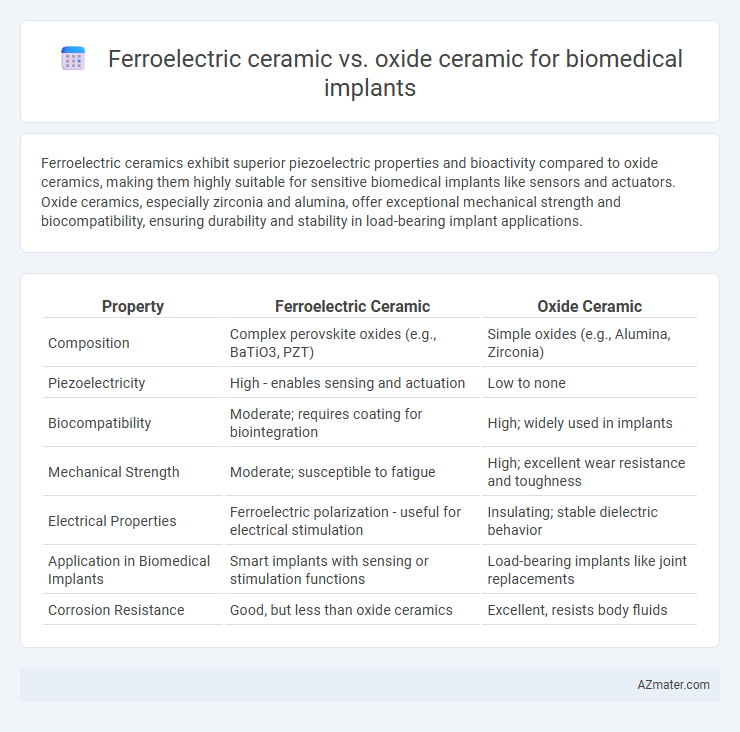Ferroelectric ceramics exhibit superior piezoelectric properties and bioactivity compared to oxide ceramics, making them highly suitable for sensitive biomedical implants like sensors and actuators. Oxide ceramics, especially zirconia and alumina, offer exceptional mechanical strength and biocompatibility, ensuring durability and stability in load-bearing implant applications.
Table of Comparison
| Property | Ferroelectric Ceramic | Oxide Ceramic |
|---|---|---|
| Composition | Complex perovskite oxides (e.g., BaTiO3, PZT) | Simple oxides (e.g., Alumina, Zirconia) |
| Piezoelectricity | High - enables sensing and actuation | Low to none |
| Biocompatibility | Moderate; requires coating for biointegration | High; widely used in implants |
| Mechanical Strength | Moderate; susceptible to fatigue | High; excellent wear resistance and toughness |
| Electrical Properties | Ferroelectric polarization - useful for electrical stimulation | Insulating; stable dielectric behavior |
| Application in Biomedical Implants | Smart implants with sensing or stimulation functions | Load-bearing implants like joint replacements |
| Corrosion Resistance | Good, but less than oxide ceramics | Excellent, resists body fluids |
Introduction to Biomedical Implant Ceramics
Biomedical implant ceramics such as ferroelectric and oxide ceramics play essential roles in medical device fabrication due to their biocompatibility, mechanical strength, and electrical properties. Ferroelectric ceramics, like barium titanate and lead zirconate titanate, offer unique piezoelectric and dielectric features beneficial for bio-sensing and neural stimulation implants. Oxide ceramics, including alumina and zirconia, provide superior wear resistance and corrosion stability, making them ideal for load-bearing joint replacements and dental implants.
Overview of Ferroelectric Ceramics
Ferroelectric ceramics, such as lead zirconate titanate (PZT), exhibit spontaneous electric polarization reversible by an external electric field, enhancing their piezoelectric properties for biomedical implants. These materials offer superior sensitivity and energy conversion efficiency compared to traditional oxide ceramics, making them ideal for sensors, actuators, and implantable devices requiring precise biomechanical signal detection. Their biocompatibility and ability to interact electrically with biological tissues enable advanced functionalities like real-time monitoring and stimulation in medical applications.
Properties of Oxide Ceramics
Oxide ceramics exhibit exceptional biocompatibility, corrosion resistance, and mechanical strength, making them ideal for long-term biomedical implants. Their chemical stability and inertness prevent adverse tissue reactions and minimize ion release in the body. Furthermore, oxide ceramics such as alumina and zirconia offer excellent wear resistance, ensuring implant durability under physiological conditions.
Biocompatibility: Ferroelectric vs Oxide Ceramics
Ferroelectric ceramics exhibit inherent piezoelectric properties that enhance cellular interactions and promote tissue regeneration, making them highly suitable for biomedical implants. Oxide ceramics, like alumina and zirconia, are widely recognized for their excellent biocompatibility, chemical stability, and low toxicity in medical applications. Compared to oxide ceramics, ferroelectric ceramics offer superior bioactivity and can stimulate cellular responses, but they require careful surface modification to optimize long-term biocompatibility.
Mechanical Strength and Durability Comparison
Ferroelectric ceramics exhibit superior mechanical strength and enhanced durability compared to oxide ceramics, making them more suitable for biomedical implants subjected to repetitive stress and load-bearing applications. Their intrinsic piezoelectric properties contribute to improved stress distribution and resistance to fatigue fractures, extending the implant's functional lifespan. Oxide ceramics, while biocompatible, generally possess lower fracture toughness and are more prone to crack propagation under cyclic mechanical stress.
Piezoelectric Properties and Biomedical Applications
Ferroelectric ceramics such as lead zirconate titanate (PZT) exhibit superior piezoelectric coefficients compared to oxide ceramics like alumina and zirconia, enabling efficient energy harvesting and sensing in biomedical implants. The high piezoelectric response of ferroelectric ceramics facilitates precise stimulation and monitoring of biological tissues, crucial for applications including bone regeneration and neural interfaces. Oxide ceramics offer enhanced biocompatibility and mechanical strength but generally lack the strong piezoelectric characteristics needed for active biomedical devices.
Surface Modification and Biointegration
Ferroelectric ceramics exhibit unique piezoelectric properties advantageous for biomedical implants by enhancing cell adhesion and proliferation through surface polarization. Oxide ceramics, such as alumina and zirconia, provide excellent biocompatibility and mechanical stability, with surface modification techniques like ion implantation and plasma treatment improving osseointegration and reducing inflammatory responses. Optimizing surface roughness and chemistry on both ceramic types promotes protein adsorption and biointegration, crucial for long-term implant success.
Long-term Stability and Degradation Behavior
Ferroelectric ceramics exhibit superior long-term stability in biomedical implants due to their inherent polarization retention and resistance to fatigue under physiological conditions, which supports consistent signal transduction and mechanical performance. Oxide ceramics, while biocompatible and corrosion-resistant, may experience phase transformations and surface degradation over extended implantation periods, potentially compromising implant integrity. The unique crystal structure and domain switching in ferroelectric ceramics reduce degradation rates compared to conventional oxide ceramics, enhancing implant longevity in vivo.
Clinical Performance and Case Studies
Ferroelectric ceramics, such as lead zirconate titanate (PZT), exhibit superior piezoelectric properties that enhance mechanoelectrical transduction in biomedical implants, leading to improved bone regeneration and neural stimulation outcomes in clinical case studies. Oxide ceramics like alumina and zirconia are favored for their exceptional biocompatibility, chemical inertness, and mechanical strength, resulting in high success rates in load-bearing orthopedic implant applications. Comparative clinical performance data reveal that ferroelectric ceramics excel in functional bioactivity, while oxide ceramics provide reliable long-term stability and lower implant rejection rates.
Future Trends and Innovations in Implant Ceramics
Ferroelectric ceramics offer promising potential for biomedical implants due to their unique piezoelectric properties, enabling self-powered sensing and stimulation, which enhances tissue integration and monitoring. Emerging oxide ceramics like doped zirconia and alumina are being engineered for improved toughness and biocompatibility, addressing long-term implant stability and reducing inflammatory responses. Future trends focus on hybrid composites combining ferroelectric and oxide ceramics to optimize mechanical durability, electrical functionality, and bioactivity for next-generation smart implants.

Infographic: Ferroelectric ceramic vs Oxide ceramic for Biomedical implant
 azmater.com
azmater.com